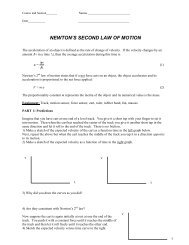force
force
force
Create successful ePaper yourself
Turn your PDF publications into a flip-book with our unique Google optimized e-Paper software.
to determine the acceleration. The acceleration is the quantity we will be measuring. Wesolve equation (3) for the acceleration and substitute what we know about F W2 = −M 2·g:FW 2M2a = = − ⋅ gM + M M + M12How do we assign signs to the different <strong>force</strong>s? Both Atwood and half Atwood machinesperform in fact one dimensional motion. The pulley just folds the direction. In whatfollows we reverse the direction of the vertical axis such that down is taken as positive.The action of object 2 is down and so it’s positive (all vectors pointing down are nowpositive). The acceleration is determined by Newton’s 2 nd law.12The measured data can be compared to this prediction and serve to confirm or refute itsvalidity:aM1M+ M2g2= (4)In this experiment, you will use a "smart pulley" to measure the speed of the system afterthe hanging mass is released. You will then find the acceleration from the slope of thevelocity-time curve.Preliminary questions1. In this experiment, we will measure the speed (v) of the cart as a function of thetime. What should a graph of v vs. t look like?Speed / m/sTime / s2. When I do this experiment with M 2 = 50g, I find an acceleration of 0.5 m/s 2 . If Idouble M 2 but do not change M 1 , what will the acceleration be?a. 1.0 m/s 2b. greater than 1.0 m/s 2c. between 0.5 and 1.0 m/s 2d. Impossible to determine which of the above is correct without knowing M 1 .
ProcedureOpen Data Studio, select Create Experiment, select the smart pulley and connect it to theinterface. Make sure the pulley read the velocity: you can spin the pulley with your handto show how the speed is registered on a velocity versus time graph.If you don’t see the velocity on the graph, align the position of the pulley with thephotogate (there is a laser beam going across the photogate. The laser beam must passtrough the pulley in order for the velocity to be acquired).Set the track to be horizontal with the use of the bubble level and some sheets of paper.Start with no masses on the hanger, so the hanging mass is just the hanger itself, 50 (or100) g. Pull the cart back until the hanging mass is just below the pulley. Click the"start" button, and release the cart. Be sure to stop the cart before it hits the pulley!Now click the stop button.You should have a plot of v(t) vs. t, and it should show that the cart had a constantacceleration after you released it. How can you tell?Measure the acceleration by taking the slope, and record it in the table below.Now add mass...say, 50 grams... to the hanger and measure the acceleration. Repeat thisuntil you have at least 6 sets of data and make sure to have the two values M 2 = 100g andM 2 = 200 included (you will need to look at these two values to be able to answer the lastquestion). It might be convenient to record your data in an Excel file, to facilitate the plotM 2 a rAnalysisAccording to equation (4), the acceleration of this system should be proportional to thequantityrMM + M2= (5)12Find the mass of the cart and write down the values of r for each runs in the third column.Record the mass of the cart here:
M cart = ____________Use Excel (or pencil and paper) to plot the acceleration versus r. Fit the data with astraight line and find its slope. According to equation (2), this slope should equal g.Compare your experimental result to the accepted value.Turn in a printed copy the Excel (or paper) plot.QuestionTake a look at your prediction, preliminary question 2. Then look at your data to see ifyour prediction was right. If not, give the correct answer here and explain why it is thecorrect answer.
















